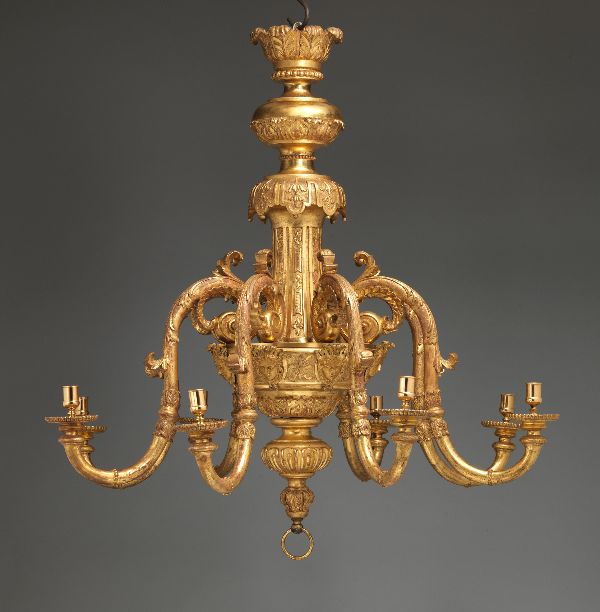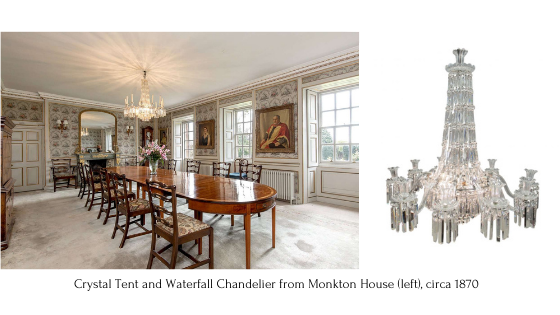
A Short History of Antique Chandeliers
|
Friday 26th March 2021 at 15:49 |

This is a guest post from dealer Georgian Antiques.
As we mentioned in our last article on antique lighting, the majority of British homes in the Georgian and Victorian periods were dimly lit by simple oil lamps, candles or rush lights.
The wealthiest citizens also had different lighting fixtures that could be used for special occasions, such as dinner parties, balls and the like. These were both decorative and highly functional pieces, including: wall sconces, stylised candlesticks, candelabra, torcheres, girandole mirrors and antique chandeliers.

Wolfgang Sauber, CC BY-SA 4.0 , via Wikimedia Commons
The term ‘chandelier’ was adapted from the French ‘chandelle’ (meaning candle) and first used in the early 18th century. However, chandeliers actually originated in the Medieval period and were primarily found in churches and royal palaces across Europe. They were originally adapted from a ‘candle-beam’ which was a simple wooden beam cross with one or more cups at the end to hold the candles.
Very few of the earliest examples of chandeliers survive today, but one can be seen at the Victoria and Albert Museum, who note that:
It is also a rare example of an iron chandelier. At this date [In the late 15th century], most chandeliers were made of brass which was cast and reproduced in moulds making them cheaper.
After this period, chandelier styles changed drastically and they started making their way into the homes of wealthier citizens including noblemen and merchants. By the 18th century, chandeliers made of brass or glass (or a combination of both!) were produced across Europe, including in Venice, the Netherlands, Germany and Great Britain.

Similarly to renowned cabinetmakers of the time, certain designers and architects, including Daniel Marot (who was the architect for William III) produced chandelier catalogues and pattern books. One of the pages of these catalogues can be seen above.
The chandelier below (now in the Met Museum, NYC) and dating from circa 1710-15 is in the ‘French arabesque manner' of one of Marot’s designs. It shows some of the key features found on chandeliers in this period, including scrolling branches (arms) and decorative drip pans or trays (a dish fitted around the base of the candle to catch melting wax).

It is also worth remembering that glass making during the Georgian and Victorian era was a relatively expensive process, and so glass chandeliers were a prized possession.
In the 18th century, crystal glass or lead crystal (molten glass mixed with molten lead which retained its transparency and gave the glass a clear brilliance) began to be used in art glass, tableware and also chandeliers. There was an array of fine cut glass produced in England and Ireland.
The description of chandeliers is often based on their design. A ‘tent’ refers to the upper part of a glass chandelier, where drops are attached to the top canopy. These extend out in the shape of a tent to a wider ring (hoop). The ‘waterfall’ refers to the chains of crystal 'icicle' drops suspended beneath the lower hoop. This crystal tent and waterfall chandelier is one of our most impressive examples, with several necklaces of crystal drops and shaped branches.

Whilst chandeliers were originally made for candles, some were later converted for gas lighting and all are now converted for electricity. The 18th and 19th centuries showed great variety in terms of chandelier designs.
This is a guest post blog entry from the lovely Amelia at dealer Georgian Antiques who sell a beautiful range of antique chandeliers and antique lighting, as well as other antiques including furniture, tables, seating, collectables, clocks, fires, mirrors and pictures.
You can view their items on Antiques Boutique by clicking here.
You can also view their own website here:-
10 Pattison Street
Leith Links
Edinburgh
EH6 7HF
T: +44 (0) 131 553 7286
E: info@georgianantiques.net


